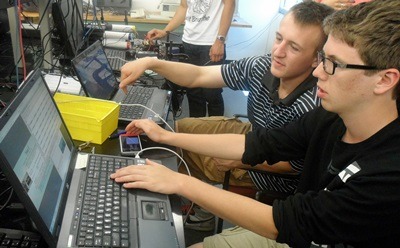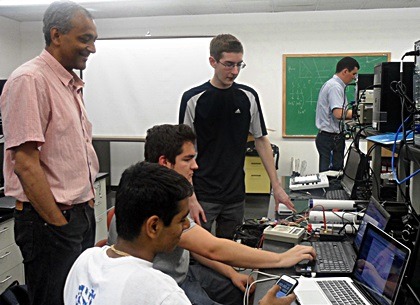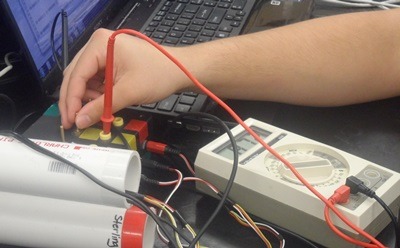
Neuqua Valley High School seniors Anders Nelson (left) and Jackson Davis (right) discuss readings recorded by their cosmic ray detector.
Accompanied by their teachers, a dozen high school students visited DeKalb this week to participate in the 2013 QuarkNet Summer Institute hosted by the NIU Department of Physics.
QuarkNet, founded in 1995, is a professional teacher development program funded by the National Science Foundation and the U.S. Department of Energy. Its goal is to involve high school teachers and their students in research that seeks to resolve some of the mysteries about the structure of matter and the fundamental forces of nature.
NIU has been serving as a QuarkNet center since 2008, and is presently one of 53 official centers in the nation. Other QuarkNet centers in Illinois are located at the University of Illinois at Chicago, Fermi National Accelerator Laboratory and Argonne National Laboratory.
The QuarkNet Summer Institute at NIU is a week-long program that provides students with opportunities to study particle physics through the use of cosmic ray detectors (CRDs). Each school receives a CRD kit donated by QuarkNet and valued at about $6,000.

NIU physicist Dhiman Chakraborty observes the students’ progress in setting up their cosmic ray detector.
“The week starts out with introductory lectures to get students and teachers familiarized with what we do and why. We also want to motivate and familiarize them with the work they’ll be doing for the week,” said NIU Presidential Research Professor Dhiman Chakraborty, who coordinates NIU’s QuarkNet program.
On day two, participants are divided into groups, and they get their cosmic ray detectors set up and functioning reliably. On the third day, they record data, and on the final day, they present their findings.
“Through this program, students get a sense of international collaboration because there are schools in Taiwan, Korea, Germany and other countries who are doing the exact same work that students in 500 schools across the United States are doing,” Chakraborty said.
“The students worldwide are uploading and sharing data with one another across the same database.”
Ultimately, the goal is to nurture and maintain the students’ interest in science.
“We hope that students walk away with some excitement for doing science and an appreciation for what science is all about,” Chakraborty said. “We don’t expect all of them to become particle physicists, but we do hope that they will consider a career in science.”
 Twelve students—coming from Neuqua Valley High School in Naperville, Metea Valley High School in Aurora and Sterling High School—participated in this week’s program.
Twelve students—coming from Neuqua Valley High School in Naperville, Metea Valley High School in Aurora and Sterling High School—participated in this week’s program.
Science teacher Daria Prawlocki from Neuqua Valley said this is her third year attending the summer institute. “The best part about this program is the opportunity for the students to talk to NIU professors and get a feel for the college atmosphere, which will hopefully encourage them to pursue a degree in science,” Prawlocki said.
“They get to see the big picture and think about some of the issues that real scientists face,” she added. “I love seeing them think about science careers.”
The high school students were eager for the opportunity to participate in this unique experience.
“We get to learn a more complex form of physics that we don’t get to go over in school, as well as to work with grad students and professors from the university,” said Jackson Davis, a 17-year-old senior from Neuqua Valley.
“We aren’t here to become experts but just to expand our knowledge of physics,” added Jeffrey Chen, a 16-year-old Nequa Valley senior.
Other annual activities of the QuarkNet center at NIU include a one-day MasterClass in spring, where a larger group of high school students takes part in analyzing particle collision data collected by the ATLAS experiment at the Large Hadron Collider at CERN, Switzerland. It is the world’s leading laboratory for particle physics, and Chakraborty leads a team of NIU physicists who participate in the ATLAS experiment there.
A select few of the students attending this week’s summer institute also will get the opportunity of doing summer internships at NIU and Fermilab, where they will get hands-on experience in real cutting-edge projects in high-energy particle physics. NIU scientists also visit the participating high schools to give lectures and interact with students several times a year. Additionally, the center has had a booth at the annual NIU STEMfest the past two years and plans to continue in future.
For additional information about the Summer Institute and other related activities, visit the NIU QuarkNet website.
Related:
